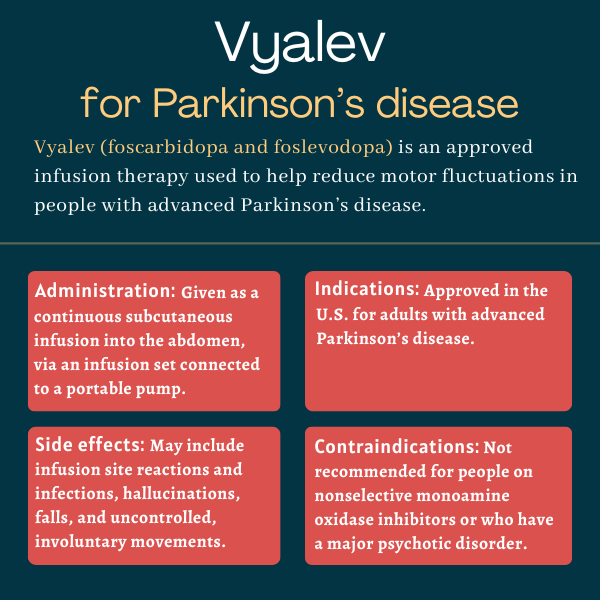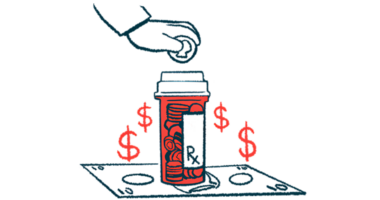Vyalev (foscarbidopa and foslevodopa) for Parkinson’s disease
Last updated Oct. 24, 2024, by Ana de Barros, PhD

What is Vyalev for Parkinson’s disease?
Vyalev (foscarbidopa and foslevodopa) is an approved injectable therapy used to reduce motor fluctuations in people with advanced Parkinson’s disease.
Developed by AbbVie, and formerly known as ABB-951, Vyalev is given by an infusion pump that continuously administers the medications via an under-the-skin, or subcutaneous, injection over 24 hours.
Therapy snapshot
| Brand name: | Vyalev |
| Chemical name: | Foscarbidopa and foslevodopa |
| Usage: | Used in advanced Parkinson’s disease to reduce motor fluctuations |
| Administration: | Continuous subcutaneous infusion |
How does Vyalev work?
Parkinson’s disease is caused by the death and dysfunction of nerve cells in the brain that are responsible for making dopamine, a chemical messenger that’s essential for motor control.
Oral levodopa, a precursor of dopamine that can reach the brain, is a mainstay Parkinson’s treatment that works by providing the raw materials for making dopamine. However, traditional tablet forms may result in variable doses of levodopa reaching the brain, due to variable absorption in the digestive system.
As such, the therapy is commonly combined with carbidopa, which prevents levodopa from being converted into dopamine before it reaches the brain. The combination increases the levels of levodopa reaching the brain, thereby helping to reduce the doses needed and its associated side effects.
While levodopa/carbidopa therapy is generally effective at controlling Parkinson’s symptoms, patients commonly end up experiencing off episodes, especially in more advanced stages of the disease. Off episodes are periods when the effects of levodopa-based treatments wear off before the next dose, and motor symptoms return.
Vyalev is a soluble formulation of foscarbidopa and foslevodopa, which are prodrug versions of levodopa and carbidopa, respectively. Prodrugs are inactive molecules that are metabolized into the active medicine once they are inside the body.
The therapy is administered continuously and directly under the skin, where it can be absorbed into the bloodstream, through a minimally invasive and convenient mode. By avoiding the digestive system, Vyalev is expected to deliver a more consistent dose of levodopa to the brain and start working faster than the oral formulation of the medication, thus reducing off time.
This delivery method also has the potential to be as effective as AbbVie’s Duopa, also known as levodopa/carbidopa intestinal gel, without the need for surgery.
Duopa, sold as Duodopa in Europe and other countries, is an approved therapy to reduce motor fluctuations in Parkinson’s patients. It delivers a continuous infusion of levodopa/carbidopa through a tube inserted into the small intestine, bypassing the stomach and allowing the therapy to be more quickly absorbed. However, this route requires surgery to place the tube.
Who can take Vyalev?
Vyalev was approved by the U.S. Food and Drug Administration (FDA) in October 2024 for treating motor fluctuations in adults with advanced Parkinson’s disease.
This decision made Vyalev the first and only continuous, subcutaneous, levodopa-based therapy to receive FDA approval for the treatment of Parkinson’s.
The therapy is approved for the same indication in 34 other countries, including Canada and the U.K., as well as in the European Union. In Europe, it is sold under the brand name Produodopa.
Who should not take Vyalev?
Vyalev is contraindicated, or not recommended, for people who are using a nonselective monoamine oxidase (MAO) inhibitor, a type of antidepressant medication, or who have received one in the previous two weeks. Combining Vyalev with an MAO inhibitor may lead to hypertension, or an increase in blood pressure.
The treatment also should not be administered to individuals with major psychotic disorders, as it may worsen the symptoms of psychosis.
How is Vyalev administered?
Vyalev is continuously administered into the abdomen via a subcutaneous infusion set that’s connected to a portable pump. It can be self-administered, or administered with assistance from a caregiver, after adequate training by a healthcare provider.
The medication is available in single-dose glass vials containing 10 mL of a clear to slightly opaque, colorless to yellow or brown solution. Each vial contains 120 mg of foscarbidopa and 2,400 mg of foslevodopa.
Vials should be stored in a refrigerator at temperatures between 2 C to 8 C (36 F to 46 F), and can be kept at room temperature (up to 30 C or 86 F) for a maximum of 28 days. Before using, a single vail should be taken out of the refrigerator 30 minutes before to ensure the medication is at room temperature when infused.
The specialized pump, approved under the brand name Vyafuser, is provided separately and allows patients to change infusion rates or doses. Additionally, sterile infusion components, including a syringe, infusion set (cannula) and vial adapter, are also necessary.
When preparing Vyalev for infusion, the entire contents of a vial should be transferred into a syringe using a vial adapter. This syringe should then be placed inside the pump, which will continuously move the medication through a tube and into a cannula that’s placed in the abdomen.
Patients should avoid injecting the area surrounding the navel as well as areas that are tender, bruised, red, or hard to touch. The cannula can remain in place for up to three consecutive days, after which patients should rotate the infusion site and use a new cannula.
The maximum recommended daily dose of Vyalev is 3,525 mg of foslevodopa (equivalent to approximately 2,500 mg of levodopa). The prescribed dose is determined based on the levodopa dose the patient was previously receiving, and a continuous infusion rate is programmed into the pump by a healthcare provider.
Infusion rates can be adjusted in small increments of 0.01 mL per hour, which corresponds to approximately 1.7 mg of levodopa per hour. A healthcare professional can also pre-program the pump with two alternative continuous infusion rates (low and high) that may be selected by the patient for different functional needs. For example, a low dose may be used at night, and a high dose when patients engage in prolonged intense activity.
When starting Vyalev in an off state, or restarting Vyalev after more than three hours without a continuous infusion, an optional loading dose can be given immediately before initiating the continuous infusion to quickly get symptoms back under control. This loading dose can be either Vyalev or oral carbidopa/levodopa tablets.
The pump can also be programmed by a healthcare provider to deliver an extra dose of Vyalev in case patients need more levodopa to control their symptoms. This is limited to no more than one extra dose per hour. If two or more extra doses are needed in a 24-hour period, patients may need to adjust their base continuous infusion rate.
To avoid potential issues when Vyalev treatment is interrupted, healthcare providers should prescribe a backup oral carbidopa/levodopa medication. If treatment is interrupted for more than an hour, it is important to replace the infusion set, including tubing and cannula, and use a new injection site.

Vyalev in clinical trials
Vyalev’s approval was mainly supported by data from a Phase 3 study called M15-736, in which the therapy was deemed safe and significantly better than oral immediate-release carbidopa/levodopa at controlling symptoms of Parkinson’s disease.
A Phase 1 study showing the therapy achieved comparable levels of levodopa in the bloodstream as Duopa, and another Phase 3 trial called M15-741 also supported its application and approval.
M15-736 Phase 3 trial
The M15-736 trial (NCT04380142) enrolled 141 adults with advanced Parkinson’s at 65 sites across the U.S. and Australia. All were experiencing at least 2.5 hours of daily off time, on average, while on standard oral levodopa/carbidopa treatment.
Participants were randomly assigned to receive either Vyalev and oral placebo capsules, or immediate-release oral levodopa/carbidopa and a subcutaneous placebo infusion, for 12 weeks, or about three months. Dose adjustments were allowed in the first four weeks to maximize clinical efficacy.
The trial’s main goal was to assess changes in good on time, when symptoms are adequately controlled without troublesome dyskinesia, or uncontrolled, involuntary movements, which are a common side effect of oral levodopa/carbidopa therapies.
After 12 weeks, Vyalev-treated patients had experienced a significantly greater increase in daily good on time compared with those on oral levodopa/carbidopa (2.72 vs. 0.97 hours). Consistently, daily off time dropped by an average of 2.75 hours with Vyalev and by 0.96 hours with the oral treatment.
In addition, a smaller proportion of patients on the experimental therapy reported being off at the time of waking relative to those on oral levodopa/carbidopa (17% vs. 63%). This difference was observed despite patients on the oral therapy being allowed to take a night-time dose if needed.
Safety findings were generally comparable between Vyalev and the oral treatment.
Participants who completed the trial had the option to enroll in an open-label extension study (NCT04750226), which is slated to run through 2026. All patients are being treated with Vyalev for up to 96 weeks, or nearly two years, and monitored for long-term outcomes.
M15-741 Phase 3 trial
Another Phase 3 trial (NCT03781167), called M15-741, recruited 244 Parkinson’s patients who were experiencing 2.5 hours or more of daily off time while on oral levodopa/carbidopa treatment — the average daily off time was nearly six hours. All participants were treated with Vyalev for up to one year.
The results showed that Vyalev increased on time without troublesome dyskinesia and reduced off time as early as after one week of treatment. After one year on Vyalev, average daily off time was reduced by 3.5 hours (a 59% reduction), and daily on time increased by 3.8 hours on average (a 41% increase).
The proportion of patients who reported unusual slowness and difficulty moving upon waking (morning akinesia) dropped from 77.7% to 27.8%. Improvements were also found in measures of sleep and quality of life, as well as in motor aspects of experiences of daily living and motor complications, as measured with the Unified Parkinson’s Disease Rating Scale parts 2 and 4.
Patients who completed the one-year trial could choose to continue treatment for up to nearly two years in an extension study (NCT04379050) that is collecting long-term data on the safety and efficacy of Vyalev.
Common side effects of Vyalev
The most common side effects of Vyalev reported in clinical trials were:
- infusion site reactions, such as rash, nodules, pain, and swelling
- infusion site infections, such as cellulitis
- hallucinations
- dyskinesia.
Falling asleep during daily activities
Levodopa-based therapies have been associated with episodes of falling asleep during daily activities, sometimes with no warning signs of somnolence. Before starting Vyalev treatment, it is important for patients to assess, and discuss with a healthcare provider, any contributing factors to increased sleepiness, such as sleep disorders and use of sedative medications.
In cases of severe daytime sleepiness or falling asleep during activities, discontinuing treatment should be considered. If patients choose to continue therapy, they should avoid driving and other activities that may cause harm if they suddenly fall asleep.
Hallucinations, psychosis, and impulse control
Treatment with Vyalev may cause hallucinations (seeing or hearing things that are not real), psychosis, and impulse control issues such as gambling, overeating, and heightened sexual urges.
Patients with a history of major psychotic disorders should avoid Vyalev, as it may exacerbate their symptoms. If impulse control issues arise during treatment, dosage reduction or therapy discontinuation should be considered.
Infusion site reactions and infections
Treatment with Vyalev can cause reactions at the infusion site, such as skin redness, pain, swelling, nodules, bruising, bleeding, rash, or inflammation. It may also cause infusion site infections such as cellulitis.
If an infection is suspected at the infusion site, the cannula should be removed and a new one should be placed in a different area. Alternatively, patients can be given an oral formulation of carbidopa-levodopa until they can safely resume treatment with Vyalev.
High fever and confusion associated with rapid dose reductions
Stopping or quickly lowering the dose of dopaminergic therapy such as Vyalev can cause symptoms such as high fever, muscle stiffness, changes in breathing and heart rate, and confusion. To prevent this, Vyalev doses should be slowly reduced if patients choose to stop treatment.
Dyskinesia
Treatment with Vyalev may cause dyskinesia, or uncontrollable and involuntary muscle movements. If a patient experiences these, it may be necessary to reduce Vyalev’s dosage or adjust the dosage of other Parkinson’s medications.
Cardiovascular events
Carbidopa-levodopa-based therapies have been associated with cardiovascular events such as heart attacks or irregular heartbeat. Patients should therefore be regularly asked about symptoms of heart disease, especially if they have a history of those diseases.
Eye issues
Treatment with Vyalev may raise the pressure inside the eye in patients with glaucoma, a condition in which pressure in the eye is higher than normal and can damage the optic nerve. As such, those with glaucoma should have their eye pressure monitored after starting treatment.
Use in pregnancy and breastfeeding
There are no adequate data on the safety of using Vyalev in pregnant individuals, but animal studies suggest it may cause harm to a developing fetus. Thus, Vyalev should only be used during pregnancy if the benefits significantly outweigh the potential risks to the fetus.
Similarly, no data are available on the effects of Vyalev on breastfeeding individuals. However, because levodopa can be found in breast milk, caution is needed when considering Vyalev for nursing patients.
Patients who are pregnant or planning to become pregnant, or breastfeeding or planning to nurse, should discuss the potential risks and benefits with their healthcare providers.
Parkinson’s News Today is strictly a news and information website about the disease. It does not provide medical advice, diagnosis, or treatment. This content is not intended to be a substitute for professional medical advice, diagnosis, or treatment. Always seek the advice of your physician or other qualified health provider with any questions you may have regarding a medical condition. Never disregard professional medical advice or delay in seeking it because of something you have read on this website.
Recent Posts
- Pandemic stress associated with higher inflammation in Parkinson’s
- Companies team on bringing Parkinson’s treatments to brain
- Dosing begins in clinical trial of Parkinson’s cell therapy RNDP-001
- MJFF awards grants to advance 5 new targets for Parkinson’s drugs
- Experimental vaccine shows early signs of benefit in Parkinson’s
Related articles






